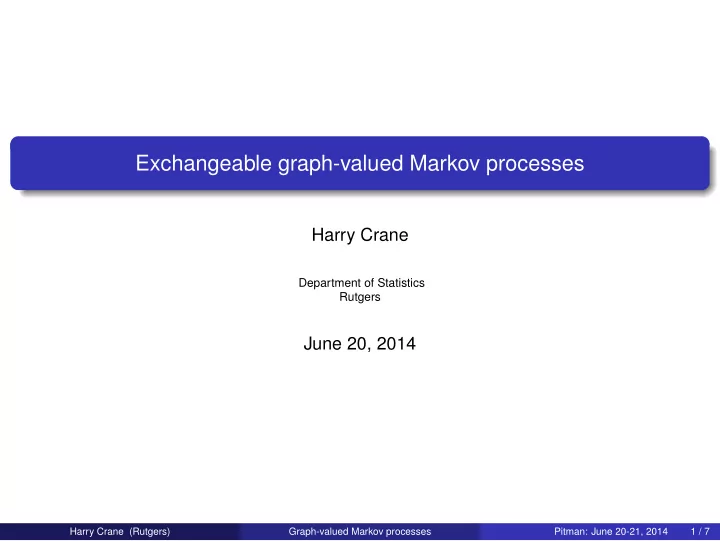

Exchangeable graph-valued Markov processes Harry Crane Department of Statistics Rutgers June 20, 2014 Harry Crane (Rutgers) Graph-valued Markov processes Pitman: June 20-21, 2014 1 / 7
Graph-valued Markov process G N : graphs with vertex set N = { 1 , 2 , . . . } . G n : graphs with vertex set [ n ] := { 1 , . . . , n } . adjacency matrix/array : G = ( G ij ) i , j ≥ 1 ∈ G N . relabeling : σ : N → N (permutation), G �→ G σ := ( G σ ( i ) σ ( j ) ) i , j ≥ 1 . restriction : G N → G n , ( G ij ) i , j ≥ 1 �→ G | [ n ] := ( G ij ) 1 ≤ i , j ≤ n . Γ = (Γ t ) t ≥ 0 is a Markov process on G N satisfying exchangeability : for all σ : N → N , Γ σ := (Γ σ t ) t ≥ 0 is a version of Γ . (Markovian) consistency : Γ [ n ] := (Γ t | [ n ] ) t ≥ 0 is a Markov chain on G n , for every n = 1 , 2 , . . . . Harry Crane (Rutgers) Graph-valued Markov processes Pitman: June 20-21, 2014 2 / 7
Weakly exchangeable arrays An exchangeable graph Γ is a weakly exchangeable { 0 , 1 } -valued array Γ = (Γ ij ) i , j ≥ 1 . Aldous–Hoover theorem: Γ = L Γ ∗ = (Γ ∗ ij ) i , j ≥ 1 with Γ ∗ ij = f ( α, ξ i , ξ j , η { i , j } ) , i , j ≥ 1 , where f ( · , b , c , · ) = f ( · , c , b , · ) and α, ( ξ i ) i ≥ 1 , ( η { i , j } ) 1 ≤ i < j are i.i.d. Uniform[0,1]. (I) overall effect: α (II) vertex effect: { ξ i } i ≥ 1 (III) edge effect: { η { i , j } } 1 ≤ i < j Harry Crane (Rutgers) Graph-valued Markov processes Pitman: June 20-21, 2014 3 / 7
Characterization of discontinuities Theorem Γ = (Γ t ) t ≥ 0 an exchangeable, consistent Markov process on G N . Then there are three types of discontinuity: (I) global jump : a positive fraction of all edges changes status; (II) single-vertex jump : a positive fraction of edges incident to a single vertex change, everything else stays the same; (III) single-edge flip : a single edge changes status, everything else stays the same. Harry Crane (Rutgers) Graph-valued Markov processes Pitman: June 20-21, 2014 4 / 7
Characterization of discontinuities Theorem Γ = (Γ t ) t ≥ 0 an exchangeable, consistent Markov process on G N . Then there are three types of discontinuity: (I) global jump : a positive fraction of all edges changes status; (II) single-vertex jump : a positive fraction of edges incident to a single vertex change, everything else stays the same; (III) single-edge flip : a single edge changes status, everything else stays the same. Harry Crane (Rutgers) Graph-valued Markov processes Pitman: June 20-21, 2014 5 / 7
Characterization of discontinuities Theorem Γ = (Γ t ) t ≥ 0 an exchangeable, consistent Markov process on G N . Then there are three types of discontinuity: (I) global jump : a positive fraction of all edges changes status; (II) single-vertex jump : a positive fraction of edges incident to a single vertex change, everything else stays the same; (III) single-edge flip : a single edge changes status, everything else stays the same. Harry Crane (Rutgers) Graph-valued Markov processes Pitman: June 20-21, 2014 6 / 7
Characterization of discontinuities Theorem Γ = (Γ t ) t ≥ 0 an exchangeable, consistent Markov process on G N . The jump measure decomposes into three parts: (I) unique σ -finite measure on { 0 , 1 } × { 0 , 1 } -valued arrays : random function W : [ 0 , 1 ] 4 × { 0 , 1 } → { 0 , 1 } (weakly exchangeable array) so that Γ t − �→ Γ t with Γ t ( i , j ) = W ( α, ξ i , ξ j , η { i , j } , Γ t − ( i , j )) , where { α ; ( ξ i ); ( η { i , j } ) } are i.i.d. Uniform[0,1]. (II) unique σ -finite measure on 2 × 2 stochastic matrices : there is a unique i = 1 , 2 , . . . for which (Γ t − ( i , 1 ) , Γ t − ( i , 2 ) , . . . ) jumps according to a 2 × 2 stochastic matrix S. (III) unique constants c 01 , c 10 ≥ 0 : determine jump rates of each edge. Comments : Compare to the Lévy-Itô characterization of exchangeable coalescent processes (binary coagulation, multiple collisions). (I) binary coagulation : two blocks merge, everything else stays the same (“continuous jumps”); (II) multiple collisions : multiple blocks merge simultaneously (“discrete jumps”). There is an associated projection of Γ into the space of graph limits. Harry Crane (Rutgers) Graph-valued Markov processes Pitman: June 20-21, 2014 7 / 7
Recommend
More recommend